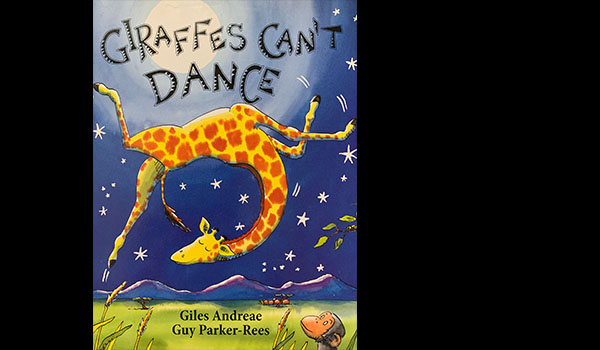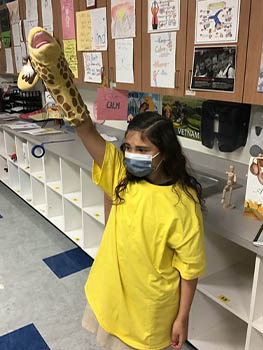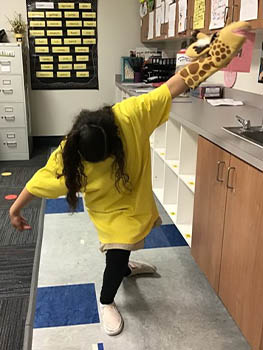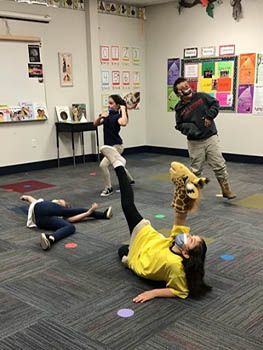All Art Lessons
SUBJECTS
GRADE
Show Results
Giraffes Can’t Dance

Lesson Summary
- Explore the art of movement and creativity using the book Giraffes Can’t Dance.
- Learn about appropriate social behaviors.
Lesson Plan and Procedure
Lesson Key Facts
- Grade(s): K, 1, 2, 3, 4, 5
- Subject(s): Dance, English Language Arts, Health
- Duration of lesson: One or two sessions, 30-60 minutes each
- Author(s): Miriam Bowen
“We all can dance…when we find music that we love.” — Gerald
Puppet Set Up
Using a puppet can help students to focus on the main character, what it is thinking, how it would move and why. To include the use of a puppet, one student is selected to play the part of the main character, Gerald, by wearing an oversized yellow t-shirt and manipulating a giraffe puppet. Be sensitive to your students and their individual needs and situations as you make this choice.  Let them know you are looking for a student that feels brave enough to wear a costume and focused enough to listen carefully to the details of the text, in order to manipulate the puppet according to the story line. Call on a student to act out the part of Gerald and help them get set up to begin the story.
Let them know you are looking for a student that feels brave enough to wear a costume and focused enough to listen carefully to the details of the text, in order to manipulate the puppet according to the story line. Call on a student to act out the part of Gerald and help them get set up to begin the story.
Teacher hint: Once you have selected a student to represent Gerald, teach them that their arm is representing the neck, and have them manipulate the puppet in the way that the narrative explains. For example, when Gerald is sad, have them bow the head and scrunch the puppet’s mouth into a frown. Side coach the student with ideas if they are struggling to follow the narrative.
Introduction
Introduce the book title, author and illustrator as you show the front cover of the book. Open to the title page and take a moment to help them recall the importance of this page. Point to the picture of the warthogs laughing under the title.
Teacher: How is the illustration on the title page helping us understand the setting? How would you feel if someone was laughing at you when you are trying something new, or giving your best effort?
This is a perfect time to establish a no laughing policy as you take the class on a movement journey.
If you feel that the group might be hesitant at first, consider reading the book once through by itself, and then reading it a second time with everyone moving.
Adding Movement to the Story
 After you have read about the Jungle Dance, take a moment to give your students the opportunity to dance as if they were part of the event. Skipping and prancing are verbs to emphasize movement choices, although let them use their creativity.
After you have read about the Jungle Dance, take a moment to give your students the opportunity to dance as if they were part of the event. Skipping and prancing are verbs to emphasize movement choices, although let them use their creativity.
Suggested Jungle Dance music: https://www.youtube.com/watch?v=qkrrZtd6aNM
Teacher: Begin and end the jungle dance with a shape that represents one of the animals you see in the illustrations. Dance as if you were part of the Jungle Dance. Use your creativity to inspire your own movements. Some words found in the text include skipping and prancing. How do these words inspire your movement? You may also create movement inspired by the animals in the story.
Dance Specific Exploration
Encourage students to try the specific dances in the book while keeping all instruction simple and age appropriate.
See examples below:
- “The warthogs started waltzing”
- Have the students imagine a partner. The waltz is a smooth dance characterized by its rise and fall action. Have students take smooth large steps while counting to three, rising and falling from the ball of the foot to the heel. Wide arm positions and turns may also be added.
- Suggested waltz music: https://www.youtube.com/watch?v=YB0xhCD47Zk
- “The rhinos rock ‘n’ rolled”
- The twist is an easy dance inspired by rock and roll music. Both feet are in contact with the floor approximately shoulder width apart. The arms are held out from the body, bent at the elbow. Begin twisting the hips with the arms and feet going in opposite directions. If you would like a more simple way of moving for your students, invite them to try jumping, wiggling, or making up their own rock and roll moves. Just have fun dancing to the music. To begin and end this dance, have the students find a shape that would represent them playing a rock and roll instrument. Students can choose to play this instrument during the movement exploration, such as an air guitar.
- Suggested rock ‘n’ roll music: https://www.youtube.com/watch?v=TosN2G1mmTs
- “The lions danced a tango”
- This movement can be done solo or with a partner. To keep things simple, have the students walk for eight counts in one direction with one arm bent and one outstretched, then make an abrupt turn and walk eight steps in the opposite direction with opposite arms, changing position. Encourage students to count out loud to eight to help them discover the rhythm. Encourage the students to use their imagination, as if they were holding a rose between their teeth or moving elegantly and boldly.
- Suggested tango music: https://www.youtube.com/watch?v=7_Lz66OmcJo
- “The chimps all did a cha-cha”
- Keep this movement fun and playful following a “slow-slow-quick-quick-quick” kind of beat. You may also count “one-two-one-two-three-move your feet and follow me,” or say the words, cha-cha-cha-cha-cha. A drum can be used to keep the beat or vocally have the students help you say the words to keep the beat.
- Suggested cha-cha music: https://www.youtube.com/watch?v=g2FPoSbkNEI
- “Eight baboons then teamed up for a splendid Scottish Reel”
- Partner the students linking right elbows. Move in a clockwise direction while skipping. Then have them reverse directions, linking left elbows and skipping in a counterclockwise direction. Note: Make sure the students do not run or move too quickly as this can pull a partner to the ground.
- Suggested Scottish Reel music: https://www.youtube.com/watch?v=KloirePPah8
Optional: Create a dance together! Using the action words in the story, provide an opportunity for your students to try leaping, prancing, skipping, swaying, swishing and twirling. Give them time to make their own dance. Sit in a circle and invite any willing students to share their own “Jungle Dance.” After this you can take turns learning each other’s dances.
Conclusion
Teachers may choose to play this music from YouTube softly in the background as they read from the page about Gerald “listening to the branches in the breeze.”
 Continue reading through the story as it tells of Gerald’s attempts to take a turn dancing, and the outcome of this experience. Have the puppeteer finish with a bow as you read the last page.
Continue reading through the story as it tells of Gerald’s attempts to take a turn dancing, and the outcome of this experience. Have the puppeteer finish with a bow as you read the last page.
Teacher: With some help and inspiration from a friendly cricket, Gerald discovers that anyone can dance. We can create our own dancing that is not a set pattern previously choreographed. This is called improvisation which means making your movement up as you go. We can create ways of dancing that are unique to us and enjoy that way of expressing our thoughts, feelings and experiences. Begin with an interesting shape and then find ways of moving that are enjoyable to you individually. Finish the dance with an interesting ending shape.
Suggested improvisation music: https://www.youtube.com/watch?v=MvLeizd_Uz0
If this is the first experience the students have had with movement you may find it helpful to give them movement ideas through the eight basic locomotor movements of human development, such as walking, running, jumping, hopping, skipping, galloping, sliding, and leaping.
Connect and Reflect
Giraffes Can’t Dance is an effective story for teaching the concept that each individual is different.
Teacher: The jungle animals in this story help us remember that each person walks through this world in their own unique way. We can learn to embrace the differences of others as well as ourselves. We can choose to show understanding and respect for others and their points of view. Through this practice, we can build confidence and self-esteem.
Have a discussion about the feelings and emotions that Gerald and the other animals might have experienced throughout the story. Talk about how it feels when we fall and make mistakes, and how it feels when others make fun of us at those times. This can lead to a conversation about a growth mindset: a belief that our most basic abilities can be developed through dedication and hard work.
Suggested questions for the students to consider for comprehension, understanding, and forward connections:
- Do I like being taunted or laughed at? How does it make me feel? How do I think other people feel when I taunt or laugh at them?
- What is respect?
- How can we show understanding, respect and support for others and their points of view?
- What is unique about me?
- How can I be myself and share my gifts with others?
- Is anyone useless, or do we all have something to offer?
- How can I make friends?
- How can I be a good friend?
- How can I manage harmful comments?
- What do I notice as I compare and contrast yourself to Gerald?
- What observations, thoughts, feelings, and connections did I make throughout the lesson?
- How can we foster an atmosphere of inclusion and respect within our classroom community?
- When we notice differences in ourselves and others, can we look for similarities that unite us?
- How can we choose to keep trying, as we work through hard things in our lives?
- How can we encourage others?
- What is compassion?
- How can we show ourselves and others compassion as we try new and difficult things?
Learning Objectives
- Actively engage in reading with purpose and understanding.
- Explore basic concepts of dances from different periods and cultures.
- Explore creative thinking and a variety of movement through improvisation.
- Consider social-emotional concepts such as embracing diversity.
- Build confidence and self-expression.
- Reflect on personal observations and make connections to practical applications such as choosing to treat other people with kindness, compassion, and respect.
Utah State Board of Education Standards
This lesson can be used to meet standards in many grades and subject areas. We will highlight one grade’s standards to give an example of application.
Grade 3 English Language Arts
- Reading, Literature Standard 7: Explain how specific aspects of a text’s illustrations contribute to what is conveyed by the words in a story (e.g., create mood, emphasize aspects of a character or setting).
Grade 3 Dance
- Standard 3.D.CR.2: Experiment with a variety of self-identified stimuli for movement, and explore a given movement problem by improvising, selecting, and demonstrating possible solutions.
- Standard 3.D.P.6: Identify, perform and describe movements and phrases with contrasting energy and dynamics.
Grade 3 Health Education
- Standard 3.HF.3: Describe how to interact with those who are different from oneself and demonstrate ways to treat others with dignity and respect.
Equipment and Materials Needed
- Essential Materials
- Book: Giraffes Can’t Dance by Giles Andrea
- A music source or something to keep a rhythm such as a drum.
- Supplemental Materials
- A giraffe puppet: Can be purchased or handmade, cloth or paper. Ideas are listed in the additional resource section of this lesson plan.
- An oversized yellow t-shirt.
- Any art materials for extended activities listed in the additional resources.
- Music suggestions for each specific dance experience. (I like to play the music for about 30 seconds.)
- “Tribal Reunion” by Brent Lewis https://www.youtube.com/watch?v=qkrrZtd6aNM
- “How Long Will I Love You” by DJ ICE https://www.youtube.com/watch?v=YB0xhCD47Zk
- “Jailhouse Rock” by Blues Brothers https://www.youtube.com/watch?v=TosN2G1mmTs
- “La Cumparsita” by Gerardo Rodriguez https://www.youtube.com/watch?v=7_Lz66OmcJo
- “Oye Como Va” by Tito Puente https://www.youtube.com/watch?v=g2FPoSbkNEI
- “Scottish Reel” by Neil Gow https://www.youtube.com/watch?v=KloirePPah8
- Relaxing Melodic Harp with Water Sounds https://www.youtube.com/watch?v=2AJY_9lwMCM
- "Master of Tides” by Lindsey Sterling https://www.youtube.com/watch?v=MvLeizd_Uz0
Additional Resources
- Paper finger puppet: https://iheartcraftythings.com/giraffe-finger-puppet-craft.html
- Popsicle Puppet: http://www.kidssoup.com/craft-and-resource/dancing-giraffe-storytime-craft-for-preschool-and-kindergarten#sthash.AKDELKym.qjtu
- Free Template of dancing giraffe: https://www.teachingideas.co.uk
- Teachers pay teachers 17 extensions: https://www.teacherspayteachers.com/Product/Giraffes-Cant-Dance-by-Giles-Andreae-17-Book-Extension-Activities-NO-PREP-3598898
- Growth Mindset: https://www.teacherspayteachers.com/Product/GROWTH-MINDSET-Giraffes-Cant-Dance-Reader-Response-for-Kindergarten-4200644
- Giraffes Can’t Dance Silly Song: https://www.youtube.com/watch?v=Zzb5Acl-n70
- Giraffes Can't Dance Animated Read Aloud: https://www.youtube.com/watch?v=Fyl-fA65tlQ
- Fun Giraffe Facts: https://www.dosomething.org/us/facts/11-facts-about-giraffes#fn10
- Giraffe Problems written by Jory John and illustrated by Lane Smith
- How to Make a Portable Puppet Theater
Image References
Image 1: Lauren Evans
Images 2-5: Miriam Bowen

www.education.byu.edu/arts/lessons
 Download
Download